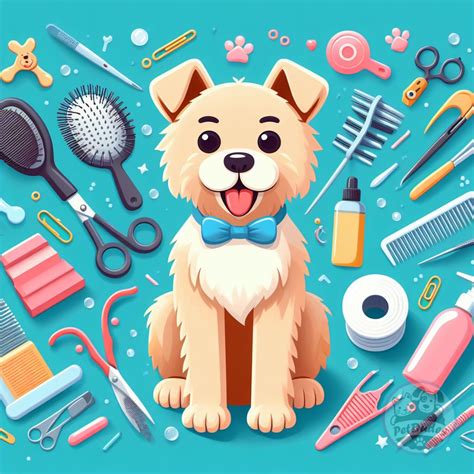Introduction
Pet grooming is an essential aspect of pet care, ensuring the health, well-being, and comfort of our furry companions. Different coat types necessitate tailored grooming practices to maintain their specific characteristics and prevent potential issues. This comprehensive guide delves into the intricacies of pet grooming for various coat types, providing insights and practical tips to keep your pet looking and feeling their best.

Understanding Coat Types
Short Coats
Short-coated pets, such as Beagles, Doberman Pinschers, and French Bulldogs, require minimal grooming. Their coats are typically smooth and easy to manage, requiring occasional brushing to remove loose hair and maintain a healthy sheen.
Medium Coats
Medium-coated pets, including Golden Retrievers, Labrador Retrievers, and Australian Shepherds, have denser coats that require regular brushing to prevent matting and tangles. They often shed seasonally, necessitating more frequent grooming during shedding periods.
Long Coats
Long-coated pets, such as Shih Tzus, Yorkshire Terriers, and Persian cats, have luxurious, flowing coats that require extensive grooming. Daily brushing is essential to prevent mats, reduce shedding, and maintain the coat’s texture and shine.
Curly Coats
Curly-coated pets, such as Poodles, Bichons Frises, and Bedlington Terriers, have unique coats that require specialized grooming techniques. Their coats are prone to tangles and mats, making regular brushing and professional grooming essential.
Wire Coats
Wire-coated pets, such as Schnauzers, Fox Terriers, and Scottish Terriers, have coarse, wiry coats that require specific grooming methods. Stripping, a technique involving the removal of dead hair by hand, is necessary to maintain the coat’s texture and prevent mats.
Grooming Techniques for Specific Coat Types
Short Coats
- Brush regularly to remove loose hair and maintain a healthy shine.
- Bathing should be infrequent, only when necessary to remove excessive dirt or odors.
Medium Coats
- Brush regularly to remove loose hair and prevent mats.
- Bathe every 1-2 weeks to keep the coat clean and reduce shedding.
- Trimming may be necessary to remove excess hair from the paws, ears, and undercarriage.
Long Coats
- Brush daily to prevent mats and tangles.
- Bathe every 2-4 weeks to keep the coat clean and lustrous.
- Trimming may be necessary to maintain a manageable length and prevent mats.
Curly Coats
- Brush daily to remove tangles and prevent mats.
- Bathe every 1-2 weeks with a conditioner to keep the coat soft and manageable.
- Clipping or scissoring may be necessary to maintain the desired style.
Wire Coats
- Strip every 4-6 weeks to remove dead hair and maintain the coat’s texture.
- Bathe infrequently to minimize the loss of natural oils.
- Trimming may be necessary to remove excess hair from the paws, ears, and undercarriage.
Grooming Tips and Tricks
- Use a brush specifically designed for your pet’s coat type.
- Brush in the direction of hair growth to avoid breakage.
- Bathe your pet using a gentle shampoo and conditioner designed for their coat type.
- Towel dry your pet thoroughly and avoid using heat styling tools.
- Regular grooming establishes a strong bond between you and your pet.
FAQs
- How often should I groom my pet?
Grooming frequency varies depending on coat type, but a general guideline is:
| Coat Type | Grooming Frequency |
|---|---|
| Short | Weekly |
| Medium | Every 1-2 weeks |
| Long | Daily |
| Curly | Daily |
| Wire | Every 4-6 weeks |
- What are the signs of an unhealthy coat?
Signs of an unhealthy coat include:
- Matting
- Tangles
- Excessive shedding
- Dryness
- Dullness
-
Odor
-
Can I groom my pet myself?
While it is possible to groom your pet yourself, professional grooming is recommended to ensure proper technique and care.
- How much does professional grooming cost?
The cost of professional grooming varies depending on the size of your pet, coat type, and services required. On average, expect to pay between $30-$80.
- Where can I find a reputable groomer?
Ask your veterinarian for recommendations or search online for groomers in your area with positive reviews.
Reviews
- “My groomer is amazing! My dog’s coat has never looked so healthy and beautiful.” – Sarah J.
- “I highly recommend professional grooming for curly-coated dogs. It’s the only way to keep their coats manageable and prevent mats.” – John C.
- “My wire-coated terrier loves his regular stripping appointments. It’s like a spa day for him!” – Mary L.
- “Grooming my long-haired cat daily has made a huge difference in her coat texture and reduced shedding.” – Emily B.
Current Status and Future Outlook
According to the American Pet Products Association (APPA), the pet grooming industry is projected to reach $10 billion by 2025. This growth is driven by the increasing number of pet owners and their willingness to invest in their pets’ health and well-being.
As the pet grooming industry continues to evolve, we can expect to see advancements in technology, products, and techniques. Specialized grooming tools and products tailored to specific coat types will become more widely available, making it easier for pet owners to provide optimal care for their furry companions.
Pain Points
Pet grooming can be time-consuming and challenging, especially for pets with long or curly coats. Additionally, the cost of professional grooming can be a barrier for some pet owners.
Motivations
Pet owners are motivated to groom their pets to maintain their health, well-being, and comfort. Grooming also strengthens the bond between owners and their pets and enhances their overall appearance.
Conclusion
Pet grooming is an essential aspect of pet care that requires tailored techniques to address the specific needs of different coat types. Regular grooming promotes a healthy coat, reduces shedding, and enhances the overall well-being of our furry companions. By understanding the intricacies of pet grooming and embracing innovative advancements, we can provide our beloved pets with the best possible care, ensuring they look and feel their very best.





















